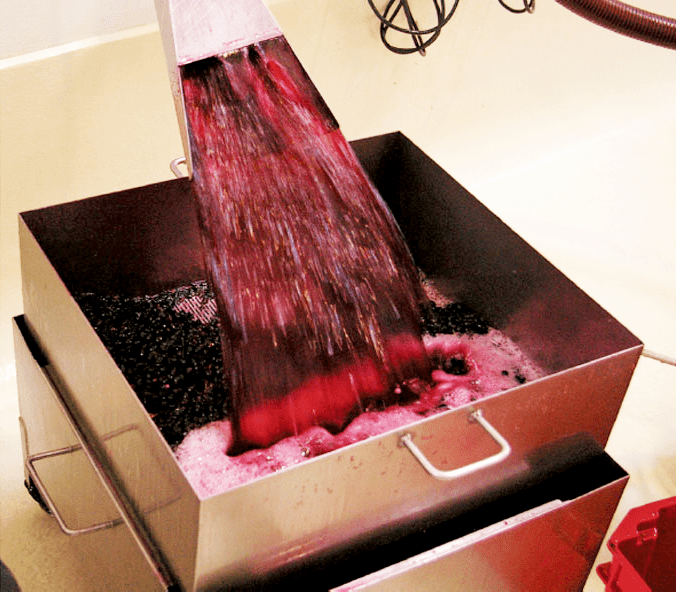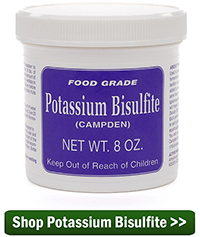 I made the County Fair peach wine and the whole time it fermented it had a bad odor. It’s done now and it tastes fine but still has the bad odor. Is there something I can do now?
I made the County Fair peach wine and the whole time it fermented it had a bad odor. It’s done now and it tastes fine but still has the bad odor. Is there something I can do now?
Thank you,
Ron
_____
Dear Ron,
When a wine has a bad odor during fermentation, it is usually because excessive amounts of gaseous compounds such as hydrogen sulfide where produced by the wine yeast during the fermentation.
All wine yeast produce some of these unwanted compounds during fermentation — some strains of yeast are more prone to over producing them than others — but any yeast can over produce hydrogen sulfide and others if put in a stressful situation.
- Lack of nitrogen is one reason why yeasts will over produce these off-odors. This is why it is important that yeast nutrient or yeast energizer is used in sufficient quantities in any fermentation you create. Both of these products are designed specifically to increase the amount of nitrogen that is available to the wine yeast.
- Fermenting your wine at too warm of a temperature can cause these bad odors to occur in a wine. The warmest temperature we recommend fermenting at is 75° F. Temperatures 80° F. and above will not only induce the production of smelly compounds, but will also help to induce the growth of unwanted micro-organisms such as bacteria and mold.
- The wine yeast is being over-worked is another major reason for having bad odors during fermentation in your wine. This usually happens when the wine yeast does not multiply properly during the first 3 to 5 days of fermentation. During the first few days of fermentation the wine yeast will typically reproduce itself to about 100 to 200 times the amount normally put in at the beginning. If this multiplying phase does not go well then you have too little yeast trying to do too much work. This type of stress causes the yeast to produce more of these compounds than it normally would. This is why it is important to have the juice exposed to air during these first few days. Air allows for the healthy reproduction of yeast cells.
The odors that these different compounds produce vary:
- Hydrogen sulfide is described by most to reek of rotten eggs.
- Diacetyl, another common compound, produces an odor of hot butter to butterscotch.
- Dimethyl sulfide smells of vegetable soup to band aids. Others will smell it as rotting cabbage or wet leather.
Mild off-odors in a newly finished wine is okay. These weaker odors will usually reduce in strength to an unnoticeable level when given a little time. But there are more severe situations where action may be required.
Aeration of the wine seems to work well in most cases. By siphoning the wine into another container in a splashing manner you can cause many of these bad odors to leave the wine at an accelerated pace. In the case of hydrogen sulfide, pouring the wine across sanitized copper or through a copper wool pad can increase its release. Both of these processes may need to be repeated more than once in order to gain sufficient improvement.
 After you are finished applying either of the above treatments, it is important to add a dose of sodium metabisulfite or Campden tablets to the wine. This does two things: 1) it helps to drive out the oxygen that was just introduced during splashing or racking (transferring) of the wine, 2) it helps to drive out any bad odors that still might remain.
After you are finished applying either of the above treatments, it is important to add a dose of sodium metabisulfite or Campden tablets to the wine. This does two things: 1) it helps to drive out the oxygen that was just introduced during splashing or racking (transferring) of the wine, 2) it helps to drive out any bad odors that still might remain.
Something else to note here. These processes should only be applied to finished wines. Wine musts that are still fermenting should be left alone to finish their due course before proceeding with any of these treatments.
If you believe there is a bad odor during you wine’s fermentation, the best thing you can do is:
- If you did not add either yeast nutrient or yeast energizer to the wine must at the beginning of fermentation, do so now. If you already have added it, you can add another 1/2 dose of either. The container they come in should have the dosages.
- Use
 a thermometer to make sure that the fermentation temperature has not exceeded 75°F. If it has, you should cool it down to between 70° and 75°F. as soon as you can.
a thermometer to make sure that the fermentation temperature has not exceeded 75°F. If it has, you should cool it down to between 70° and 75°F. as soon as you can. - You should also verify that the fermentation is moving along at a normal rate. You can track the progress of a fermentation by taking readings with a hydrometer every couple of days. If the fermentation seems slow, this could be signs of an over-worked yeast. If that’s the case, you may want to add a second packet of wine yeast.
Realize that any fermentation has smells. There are odors of alcohol, fruit, CO2 gas (carbonation) and even sulfur (lit matches). Don’t get these normal smells confused with the bad odors discussed above. These are all aromas of a healthy, vigorous fermentation.
I hope this helps you out. Bad odors coming from a fermentation is something that even the larger wineries have to address from time to time. It’s knowing how to prevent them and deal with them when they do occur that will help you progress and improve as a home winemaker.
Happy Wine Making,
Ed Kraus
—–
Ed Kraus is a 3rd generation home brewer/winemaker and has been an owner of E. C. Kraus since 1999. He has been helping individuals make better wine and beer for over 25 years.

Good information
I have picked more
Thanks
How many Camden tablets for a five gallon carboy?
5 tablets for 5 gallons.